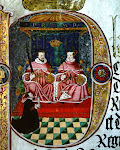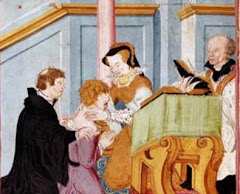This naturally raised problems. Everyone had been used to a male fulfilling this role – and the existence of a queen regnant raised a number of questions regarding the extent of her power, how much power her prospective husband should have, etc. And the coronation itself was bound to be different.
Judith Richards in her excellent article, Mary Tudor as ‘Sole Quene’?: Gendering Tudor Monarchy (1997), notes that reports regarding the coronation procession that occurred on the 30th September 1553, were mixed. The eyewitness accounts don’t add up – one contemporary noted that she wore ‘a gown of blew velvet, furred with powdered armyen’ whilst another stated that she wore a white gown and had her hair worn lose to emphasise her virginity. Others recorded that her hair was up and adorned with jewels. These disagreements may seem trivial. But Richards raises an interesting point when she notes that such differences tell us a lot about the uncertainties felt by contemporaries watching the coronation procession. They were witnessing something unseen in England – the coronation of a female ruler and it seems that no one could agree on what manner Mary should present herself. Namely, whether she should have dressed in the same colours and in the same style as a king would at his coronation procession (that is to wear blue or purple velvet), or to follow the style of the queen consort (to wear white and wear her hair loose).
So evidently the day was a puzzling as well as an exciting event. It seems that Mary did wear her hair loose – and she proceeded to have herself depicted as such in the first plea roll portrait of her (dated Michaelmas, 1533):


(Another example of Mary wearing her hair lose - a golden rial dating to c.1553/1554)
The coronation celebrations lasted over several days. On the 28th September 1553 Mary moved to the Tower (where the monarch traditionally resided before their coronation). She travelled there in a decorative barge accompanied by her sister, Elizabeth, and there was music and the sound of cannons firing to salute her. The following day she created 15 new Knights of the Bath, including the young earl of Surrey (later Thomas Howard, 4th duke of Norfolk) and William Courtenay, Earl of Devon who was a proposed marriage candidate for Mary. A number of these men were loyal allies, including William Dormer who was father to one of Mary’s most trusted ladies – Jane Dormer. Importantly, a number were religious conservatives (like Dormer). Clearly Mary was providing a taste of what was soon to come.
The 30th September marked the day of the coronation procession which started around two o’clock that afternoon. As Freda Winifred described, it ‘passed by way of Fenchurch, Gracechurch, Cornhill, Cheapside, St. Paul’s Churchyard, Ludgate and Fleet Street to Whitehall Palace’. Travelling with Mary was Elizabeth and her one time stepmother, Anne of Cleves, emphasising family solidarity. The procession was a time when the public could show their acclaim for their new monarch and throughout the procession Mary would have been greeted with fantastic displays, including some set up by various groups of merchants of the city. This included the Florentines who staged a display which compared Mary to Judith who triumphed over Holofernes (who was meant to represent the duke of Northumberland in this demonstration).
Throughout the procession Mary displayed herself as the queen consort would at a coronation, which indicates that she understood the similarities between her role and a consort’s – namely that she was a wife of sorts although in this case not to a monarch but to her country. The idea of a queen regnant wedded to her realm instantly provokes the image of Elizabeth I who famously declared that she had entered such a marriage. But despite Mary’s later decision to marry, she too believed that she had entered into an important union with her country and one which could not be affected by a temporal marriage:
“I am already married to this Common Weal and the faithful members of the same, the spousal ring whereof I have on my finger [the coronation ring]...”
(Mary’s speech in the Guildhall, 31st January 1554 recorded in John Protector, The History of Wyat’s Rebellion: With the Order and Manner of Resisting the Same (London, 1554))
Thus Mary, even as early as her coronation, was attempting to compromise the role of queen regnant with the well known one of queen consort. But unlike the consort whose role was reliant on her husband, Mary was determined to emphasise her own authority and how it was not aligned with another. And this can be found in the coronation ceremony itself when Mary managed to secure a Catholic ceremony for herself despite the fact that the country she inherited was, officially at least, separated from the Catholic Church and that her archbishop of Canterbury was one of the most notable and dedicated advocates of religious reform in the country...
References
Judith Richards, Mary Tudor (London, 2008), pp. 134-39.
Judith Richards, ‘Mary Tudor as ‘Sole Quene’?: Gendering Tudor Monarchy’, The Historical Journal, 40, 4 (1997).
Winifred Roll, Mary I: The History of the Unhappy Tudor Queen (New Jersey, 1980), pp. 130-34.
J.M. Stone, The History of Mary I Queen of England: As found in the public records, despatches of ambassadors in original private letters, and other contemporary documents (London, 1901), pp. 255-56.




Great blog and great post! Congratulations! I have never heard the word "regent" applied to a reigning queen. Usually "regent" refers to someone reigning in the place of a minor or incapacitated monarch. Perhaps I have misunderstood the full definition of the word. I am used to Mary being called a queen "regnant" but then I suppose such words might have a different meaning in different countries......
ReplyDeleteHi! Thank you for your message!
ReplyDeleteYou raise a very interesting point. I’ve seen the term ‘Queen Regent’ and ‘Queen Regnant’ used in the same context and wondered which was the more appropriate. In her latest book on Mary Tudor, Judith Richards endorsed the term ‘Queen Regnant’ although in an article I read recently on queenship the term ‘queen regent’ was endorsed for the same role. However if Richards uses it – and she is an expert on issues regarding female rule during this period – I should also be using this title. So I’m going to re-edit the post!
Excellent! I am linking to this article since many of my readers are fascinated with Mary!
ReplyDeleteI just found a CD by The Sixteen, Harry Christophers, called "Philip & Mary: A Marriage of England and Spain" with music that might have been performed on Christmas Day, 1554. The notes recount the welcome the people of England gave to the news that Mary was pregnant by Philip of Spain, even though they had previously opposed the marriage. It just demonstrates how much stability and orderly succession meant to people at the time.
ReplyDelete